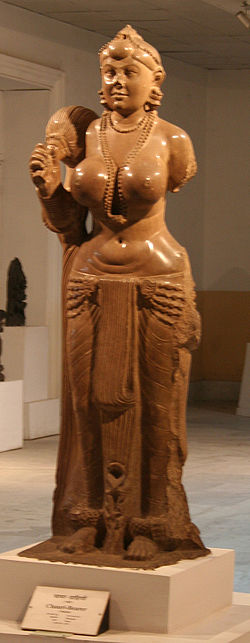- Didarganj Yakshi
-
 Didarganj Yakshi (Chauri Bearer) Patna
Didarganj Yakshi (Chauri Bearer) Patna
The Didarganj Yakshi (or Didarganj Chauri Bearer) is one of the finest examples of Mauryan art.[1]
The sculpture is currently located in the Patna Museum in Patna, India. It is 64" tall, carved out of a single piece of stone. [2]
The Didarganj Yakshi is estimated to date from ca. 3rd century BCE. [3] It was excavated from Didarganj, on the banks of the Ganges River, in 1917.
The statue's nose was damaged during a travelling exhibition, The Festival of India, en route to Smithsonian Institution and the National Gallery of Art, Washington, D.C., USA.
J.N. Samaddar
It was moved to the Patna museum by noted archaeologist, professor and historian, Dr. J N Samaddar. A specialist in Buddhist history and artefacts, Professor Samaddar carried on extensive archaeological digs throughout the areas inhabited by the Buddha, his follower the emperor Ashoka as well as documentation and excavation of architecture and artefacts of the Gupta empire and Maurya dynasty. He was also responsible for much of the work carried on for the archaeological surveys of the Nalanda University seen as one of the finest examples of higher education facilities during Buddhist India. As a passionate advocate of Buddhist philosophy and teachings, Samaddar published several books on Buddhist history, most noted amongst which is the condensation of his lecture series "The Glories of Magadha." His residential palace named Pataliputra includes several carvings of Buddhist life on its walls and the depiction of the Bodhisatva in sculptural forms. JN Samaddar was part of the community of Euro-Bengali intellectuals of the colonial era which also included poet Rabindranath Tagore, writer Sukumar Ray (film director Satyajit Ray's father) and members of the royal families of Bengal and Nepal as well as several European writers who were influenced by Eastern philosophies. However it is in this environment of independent critical thinking that far from following the dictum of the Raj, works that evoked pride in ancient Indian philosophy and heritage were evolved and its need to be free from colonialism.
References
- ^ Chaudhary, Pranava K (28 September 2006). "A fortress chockfull of chinks". Indiatimes. http://timesofindia.indiatimes.com/articleshow/2033283.cms. Retrieved 17 February 2011.
- ^ Bengal Archeology website, "Didarganj Yakshi" (7 March 2009) [1], accessed August 30, 2011.
- ^ Huntington, John C. and Susan L., The Huntington Archive - Ohio State University [2], accessed August 30, 2011.
External links
Categories:- History of Bihar
- Patna
- Mauryan dynasty
- Stone sculptures
Wikimedia Foundation. 2010.
